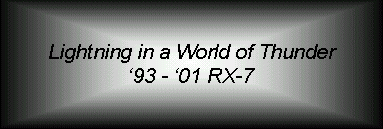

Date: Tue, 28 Apr 1998 10:41:38 -0400 Here's the latest How To from my web site. There are several pictures and
diagrams that go with it at the web site. It's 3rd generation specific but
it works pretty much the same way for the earlier cars.
Instructions
Installing an engine-bay mounted fuel pressure gauge is pretty
straightforward. You will need a 60 psi gauge, a gauge fitting for a 3/8
inch fuel line, and two, 3/8 inch hose clamps (preferably constant pressure
"spring" clamps). I ordered the parts from Summit Racing (800 230-3030) for
about $25. The gauge (liquid filled) and fitting are from Summit Racing,
gauge - part # SUM-G3126 and fitting - part # SUM-G1710 (3/8 inch)
Put about two wraps of teflon tape on the gauge's threads and screw it into
the gauge fitting. Make sure the tape doesn't extend below the threads.
Hand tight will not be enough so use a large wrench or vise to hold the
fitting and a small wrench to screw in the gauge.
The fuel line you want to tap in to is the fuel line closest to the oil dip
stick (see diagram above). It is a rubber hose that connects to a metal
pipe near the engine. Before you start cutting the hose you have to release
the fuel pressure so see the Fuel Pressure Release How-To:
http://www.geocities.com/MotorCity/Speedway/8537/release_fuel.htm. Now you
can cut the fuel line but use a rag to keep fuel from spraying on you and
have two 3/8 inch plugs ready to stop the fuel flow (it will dribble out
continuously unless you plug the hoses). The fuel lines have an insulation
tube wrapped around them which makes them look larger than 3/8 inch. I had
to remove the insulating tube from the fuel line so I could get the clamps
on the hose. The insulation tube will come right off after you cut the fuel
line. After installing the gauge and tightening the clamps you need to
prime the fuel system. See the Fuel Pressure Release How-To (above) for
instructions. Make sure there isn't any pooled fuel anywhere before you
start the engine. Take a good look for fuel leaks.
Normal idle fuel pressure is 28-32 psi. Pressure with the F/P (fuel pump)
and GND (ground) diagnosis terminals jumped should be 36-38 psi. If your
gauge goes high enough, you can check maximum fuel pressure (71-107 psi) by
plugging the fuel line on the engine side of the fuel gauge. This keeps
fuel from going to the fuel pressure regulator which bleeds off excess
pressure by returning fuel to the gas tank.
NOTE: DO NOT ROUTE A FUEL LINE INTO THE COCKPIT! TO PLACE A FUEL GAUGE IN
THE COCKPIT YOU MUST USE AN ISOLATOR OR AN ELECTRICAL GAUGE WITH A SEPARATE
PRESSURE SENDER.
If you are installing an electric pressure gauge you can install the
pressure sender in the same place in the same way and then route the output
wire through the firewall to the gauge.
From: "Robinette, Maj Robbie D."  [Mail me]
[To RX-7 Files home]
[To my home page]
[Copyright Notice]
[Mail me]
[To RX-7 Files home]
[To my home page]
[Copyright Notice]